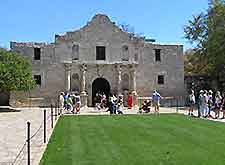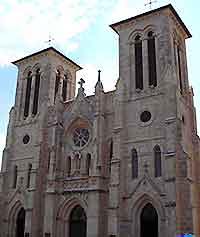San Antonio History Facts and Timeline
(San Antonio, Texas - TX, USA)

San Antonio is considered to be one of the most historical cities in the US. It is the birthplace of Texan liberty and the site of the Alamo, where a famous battle that was a pivotal event in the Texas Revolution, took place in 1836. The modern history of San Antonio dates back much further than this, however.
In 1691, the first Spanish explorers came across a river that had long been settled by Native American Indians. The day they first set foot in the settlement was the feast day of St. Anthony of Padua (13th June). The explorers honored him by naming the settlement and river 'San Antonio'. Nowadays, many of the city's 26 million annual visitors learn about the region's indigenous tribes by visiting the Institute of Texan Cultures, located on the East Cesar E. Chavez Boulevard.
Spanish Control
The Spanish established a small mission by the river in 1716, which was referred to as San Antonio de Valero. Later on, this mission became known as the Alamo. The establishment of the mission was closely followed by the creation of four more missions in the years leading up to the Battle of the Alamo in 1836.
These missions were located on the banks of the San Antonio River. Nowadays, they are part of the San Antonio Missions National Historical Park, a popular tourist attraction covering in excess of 800 acres / 325 hectares of land. The fort and settlement continued to grow during the 1720s, and the Spanish established the first Texan civil government in 1731. This Spanish settlement went on to become the biggest in the state.
The Alamo
The early 19th century was a turbulent time in the history of San Antonio. Anglo-American settlers were invited here by the then Mexican government, after it won independence from
Spain in 1821. These Anglo-American settlers and the resident Hispanic population quickly developed a unique Texan identity. The rescinding of the 1824 Mexican Constitution in 1836 led to turmoil across
Mexico. San Antonio was no exception, with Texas declaring independence and driving Mexicans from the state completely, in what was to become the Texas Revolution.
During the revolt, Mexican forces returned to take control of the city, leaving Texan leaders, such as Sam Houston, to encourage Texans to retreat from San Antonio. Over the course of two weeks, a volunteer force led by Jim Bowie and William Barrett Travis performed one of the greatest rearguard actions in history. This was a brave attempt to defend a deserted mission, the Alamo, from a series of fierce attacks by Mexican forces. A number of defending troops were executed, but these 'martyrs' only served to encourage other forces to eventually win the fight for Texan independence.
Nowadays, the Alamo is a hallowed site visited by thousands of tourists each year, many of whom are proud Texans. It is now very much the center of the city's tourist industry, being surrounded by accommodation and other attractions.

Post-Independence and the Civil War
Following a period as part of the independent Republic of Texas and cessation to the United States, San Antonio was hit hard again by the Mexican-American War from 1846 to 1848. During this conflict between the US and Mexico, more than two-thirds of the overall population was wiped out, making it a dark time in the history of San Antonio.
In the years leading up to 1860, however, the city recovered and was a prosperous place to be once more, having attracted large numbers of German settlers. The Germans developed the King William district, home to palatial residences and flour mills. A number of these buildings remain today in what is known as the King William Historic Area.
Many San Antonio locals supported the Union forces during the Civil War (1861 to 1865), and so the city was left largely unscathed. After the war, it continued to gain a reputation as a unique and beautiful frontier city, with a melting pot of cultures.
Modern Times in the City
The early part of the 20th century saw large-scale development in San Antonio, with streets widened to cater for the growing number of cars.
Despite the destruction of a number of historical buildings, other masterpieces such as the Aztec on the River began to spring up. This cinema, which was first built in 1926, was restored in 2006 and is now one of San Antonio's best-known attractions.
 San Antonio is considered to be one of the most historical cities in the US. It is the birthplace of Texan liberty and the site of the Alamo, where a famous battle that was a pivotal event in the Texas Revolution, took place in 1836. The modern history of San Antonio dates back much further than this, however.
San Antonio is considered to be one of the most historical cities in the US. It is the birthplace of Texan liberty and the site of the Alamo, where a famous battle that was a pivotal event in the Texas Revolution, took place in 1836. The modern history of San Antonio dates back much further than this, however.